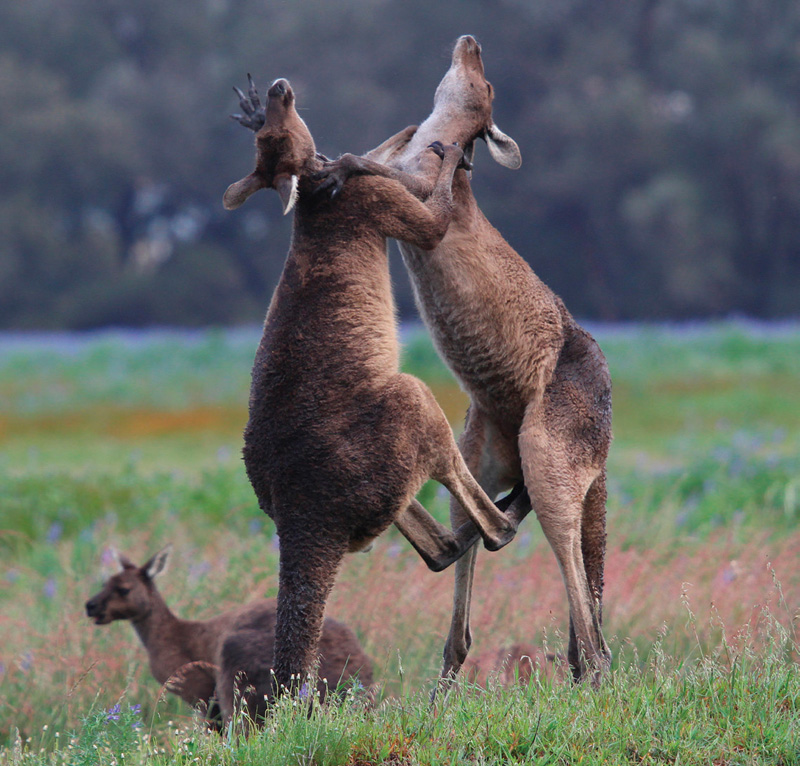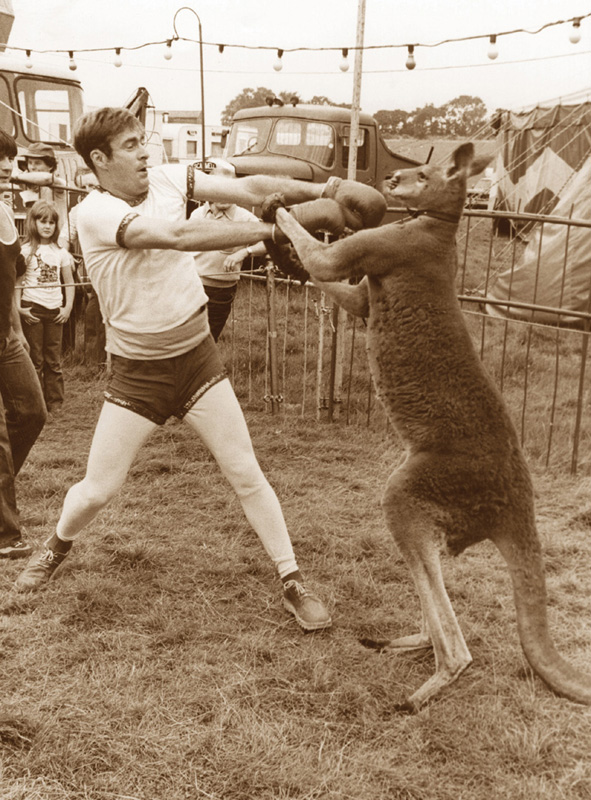91 Box with a kangaroo
WHAT IT IS Mixing it with a marsupial
WHY YOU WON’T DO IT Skippy never read the Queensberry Rules
The Australian Olympic movement uses an image of boxing kangaroo as its official mascot – it’s a natural choice, considering that the ‘roo is the country’s most iconic animal, and its anthropomorphic boxing stance reflects the Aussie never-say-die attitude to sporting matters. But would you really want to take on one of these pugnacious marsupials in the ring?
Although some people dismiss the idea of boxing kangaroos as a modern myth or at least a misinterpretation of other behaviours, the fact of the matter is that kangaroos really do box. While both the males and females can spar, it is perhaps no great surprise that it is the male of the species (the buck) that most often partakes. While young joeys playfully bash each other about, among adults it can be a rather more serious business, with contests frequently arising in order to establish the social hierarchy, to sort out territorial claims or simply to impress females. However, there is a vast gulf between these nature-driven engagements and the man-versus-beast contests of popular imagination.
ROO’D BEHAVIOUR Two Western grey kangaroo males lay into each other in Western Australia. Males stand about 1.3 metres (4 ft 8 in) tall and can weigh more than 50 kilograms (110 lb). Fights break out as a way to establish social hierarchy within large kangaroo groups, as well as to assert mating rights over rival males.
Film footage from a hundred and more years ago – when animal rights were taken less seriously than today – shows men slugging it out against kangaroos who really did have their paws tied into boxing gloves, and despite the efforts of international animal welfare organizations, contests are still held in some parts of the world. In reality, however, kangaroos are largely peaceable creatures that do not go looking for trouble – and the last recorded case of a human being killed in a kangaroo attack was in 1936.
Nonetheless, it is not out of the question that you might find yourself unexpectedly pitted against a kangaroo in the wild. In 2010, for instance, jogger David Striegl was attacked from behind while running on Mount Ainslie near Canberra – a single smack to the head was enough to knock him out cold. The motivation for the attack was never established: it could be that he inadvertently looked at the kangaroo the wrong way, but the animal was probably responding to a perceived encroachment on its territory.
So what can you do to emerge from a brush-up mostly intact? Firstly, try not to antagonize the animal. There are three principal reasons why one is likely to get annoyed with you: if it sees you as a threat to its territory, if it thinks you are muscling in on its mates, or if it suspects that you are withholding food.
Read the signals: an aggressive kangaroo will raise itself up, arch its back and tense its muscles. Pulling up grass is another tactic used to intimidate rivals. The aggressor may also go in for a bit of shadow boxing, and in the wild will grab an opponent by the throat to commence a scuffle. If you spot any of these signs, attempt to defuse the situation. Keep your distance if possible, and try to put a barrier between you and the animal – even holding a large branch against you can help. Try to make a slow retreat, but don’t try to outrun the ‘roo – when it catches you up (and it will) you will be at your most vulnerable. Displaying submissiveness can also deflect a tussle (even if it dents your pride): avoid eye contact, assume a crouching position and let out a short, low grunt to admit defeat.
If it comes to a fight, your chances of defeating a kangaroo in close combat are not good. Of all the kangaroo breeds, the largest is the red kangaroo, which can be up to 2 metres (6 ft 8 in) tall and 90 kilograms (200 lb) in weight. They can give you a nasty swipe with their front paws, but it is the powerful hind legs that are really dangerous. Using their tails for balance, they will kick at your abdomen with claws sharp enough to disembowel.
Aim for self-preservation. Protect your face and vital organs as best you can. Turning your body sideways will offer a narrower target to your assailant. Even better is to roll into a ball and hope the kangaroo eventually gets bored and goes home.
HAVING A POP Better known in Britain these days as a sober commentator on pop history, former BBC Radio One disc jockey Paul Gambaccini somehow found himself on the wrong end of a boxing contest with a kangaroo at a circus in Eastbourne, England, in the summer of 1980.

